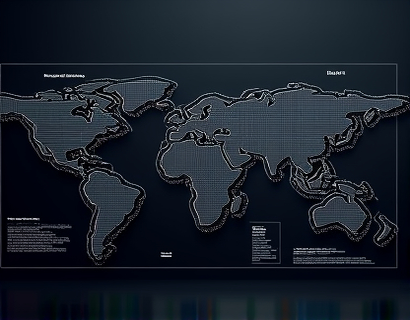Advanced Tools for Graph Theory and Fluid Dynamics Research: Empowering Insights and Optimization for Researchers and Engineers
In the realm of applied mathematics, graph theory and fluid dynamics stand as pivotal fields that drive innovation and deepen our understanding of complex systems. Researchers and engineers in these domains face the challenge of analyzing intricate networks and fluid behaviors, which often require sophisticated tools and methodologies. Advanced tools for graph theory and fluid dynamics research have emerged, significantly enhancing the capabilities of professionals in these fields. These tools streamline data analysis, improve visualization, and facilitate groundbreaking discoveries, ultimately leading to optimized performance and innovative solutions.
Graph Theory Tools: Unraveling Complex Networks
Graph theory, a branch of mathematics that studies the properties of graphs, which are collections of vertices connected by edges, plays a crucial role in modeling various real-world systems. From social networks to transportation systems and biological networks, graph theory provides a powerful framework for understanding and analyzing these complex structures. Advanced tools in graph theory empower researchers and engineers to delve deeper into the intricacies of these networks, uncovering hidden patterns and insights.
One of the key features of modern graph theory software is its ability to handle large-scale networks efficiently. These tools employ sophisticated algorithms to perform tasks such as shortest path calculations, network flow analysis, and community detection. For instance, the use of parallel computing and distributed systems allows for the processing of massive datasets, making it feasible to analyze networks with millions of nodes and edges. This capability is particularly valuable in fields like telecommunications, where understanding the robustness and efficiency of network topologies is critical.
Visualization is another critical aspect of graph theory research. Advanced visualization tools enable researchers to create interactive and dynamic representations of graphs, making it easier to identify patterns, anomalies, and relationships. These visualizations can be enhanced with color coding, size variations, and other graphical elements to highlight important features of the network. Such visual aids are invaluable for presenting findings to both technical and non-technical audiences, facilitating better communication and collaboration.
Fluid Dynamics Tools: Simulating and Analyzing Fluid Behavior
Fluid dynamics, the study of fluids in motion, is essential for a wide range of applications, including aerospace engineering, environmental science, and biomedical research. The behavior of fluids is governed by complex equations, and simulating these phenomena requires powerful computational tools. Advanced software for fluid dynamics research provides researchers and engineers with the means to model, simulate, and analyze fluid flows with high accuracy and efficiency.
Computational Fluid Dynamics (CFD) software is at the forefront of fluid dynamics research tools. These tools implement numerical methods to solve the Navier-Stokes equations, which describe the motion of fluid substances. Modern CFD software incorporates advanced solvers and mesh generation techniques, allowing for the simulation of both laminar and turbulent flows. The ability to model complex geometries and boundary conditions makes these tools indispensable for designing and optimizing systems such as aircraft, ships, and pipelines.
One of the significant advantages of advanced CFD tools is their user-friendly interfaces and extensive libraries of pre-built components. These features reduce the learning curve and enable users to focus on the scientific aspects of their research rather than the intricacies of the software. Additionally, these tools often support multi-physics simulations, allowing researchers to study the interactions between fluid dynamics and other physical phenomena, such as heat transfer and structural mechanics.
Integration of Graph Theory and Fluid Dynamics
The intersection of graph theory and fluid dynamics offers a rich field for research and application. For example, graph-based methods can be used to discretize fluid domains, simplifying the computational complexity of fluid simulations. Conversely, fluid dynamics principles can inform the design of networks and systems modeled using graph theory. Advanced tools that bridge these two domains provide a comprehensive platform for researchers to explore these synergies.
Hybrid tools that combine graph theory and fluid dynamics enable the analysis of complex systems where both network structures and fluid behaviors play a crucial role. For instance, in environmental fluid dynamics, graph theory can be used to model the spread of pollutants through a network of waterways, while fluid dynamics simulations can predict the movement and dispersion of these pollutants. Such integrated approaches lead to more accurate and insightful analyses, driving innovation in environmental management and conservation.
Data Analysis and Machine Learning Integration
The integration of advanced data analysis techniques and machine learning algorithms with graph theory and fluid dynamics tools has opened new avenues for research. Machine learning models can be trained on large datasets generated by simulations and experiments, enabling the identification of patterns and predictions of system behaviors. These models can also optimize parameters in simulations, reducing computational time and improving accuracy.
For graph theory, machine learning can enhance node classification, link prediction, and anomaly detection. In fluid dynamics, machine learning can assist in turbulence modeling, parameter estimation, and uncertainty quantification. The combination of these advanced techniques with traditional methods results in more robust and efficient research workflows.
Enhanced Visualization and Interactive Analysis
Visualization remains a cornerstone of both graph theory and fluid dynamics research. Advanced visualization tools not only provide static representations but also offer interactive and dynamic visualizations. These interactive tools allow researchers to explore data in real-time, adjusting parameters and observing the effects on the system. Such interactivity is particularly useful for educational purposes, helping students and professionals gain a deeper understanding of complex concepts.
For fluid dynamics, visualization tools can display vector fields, streamlines, and contour plots, providing insights into flow patterns and turbulence. These visualizations can be combined with graph-based representations to show how fluid behavior influences network dynamics. Interactive visualizations also facilitate the identification of critical points and regions of interest, guiding further analysis and experimentation.
Case Studies and Real-World Applications
The practical applications of advanced tools in graph theory and fluid dynamics are vast and varied. In the field of transportation, graph theory tools are used to optimize traffic flow and design efficient public transit systems. For example, by modeling road networks as graphs, researchers can identify bottlenecks and propose solutions to reduce congestion.
In environmental science, the combined use of graph theory and fluid dynamics helps in modeling the spread of contaminants in water bodies. By creating graphs that represent the network of waterways and using fluid dynamics simulations to predict contaminant movement, researchers can develop strategies to mitigate pollution and protect ecosystems.
In the aerospace industry, CFD tools are essential for the design and testing of aircraft. Advanced graph theory tools can be used to optimize the structural network of aircraft components, ensuring strength and efficiency. The integration of these tools in the design process leads to lighter, more fuel-efficient aircraft, contributing to the overall sustainability of the industry.
Future Directions and Challenges
As research in graph theory and fluid dynamics continues to evolve, the demand for more advanced and specialized tools will grow. Future developments may include even more sophisticated machine learning algorithms, real-time data processing capabilities, and enhanced user interfaces. The challenge lies in making these tools accessible to a broader audience, including those with limited computational resources or expertise.
Collaboration between software developers, researchers, and industry experts will be crucial in addressing these challenges. Open-source projects and community-driven initiatives can play a significant role in fostering innovation and sharing knowledge. By building a robust ecosystem of tools and resources, the research community can continue to push the boundaries of what is possible in graph theory and fluid dynamics.
In conclusion, advanced tools for graph theory and fluid dynamics research are transforming the way scientists and engineers approach complex problems. These tools not only streamline data analysis and enhance visualization but also open new avenues for discovery and optimization. As the field progresses, the integration of cutting-edge technologies will continue to empower researchers and engineers, driving innovation and advancing our understanding of the world around us.










































